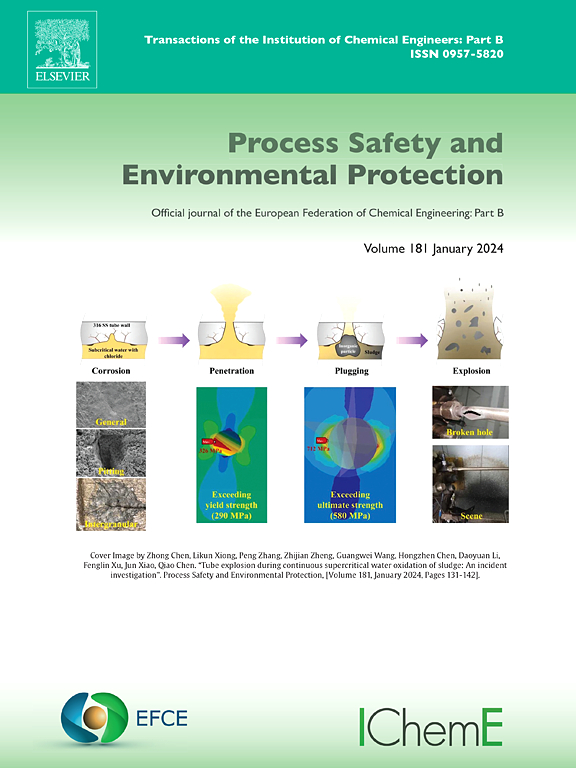Multi-physics modelling and simulation on the spontaneous heating of sulfide ores
IF 6.9
2区 环境科学与生态学
Q1 ENGINEERING, CHEMICAL
引用次数: 0
Abstract
The spontaneous combustion of sulfide ore piles poses a significant threat to miners' health and mining safety. In this work, numerical simulations of the temperature, velocity, and concentration field during the self-heating of sulfide ore piles were conducted using COMSOL Multiphysics. A self-heating model was established based on porous media fluid dynamics and heat transfer theory. The simulation parameters were determined, and the numerical solution of the heat conduction equation for sulfide ores was obtained. The results indicate a three-stage temperature progression: slow oxidation (0–10 days, with temperatures below 335 K), rapid heating (10–16 days, with a peak temperature of 926 K), and gradual cooling (16–24 days). The stacking method significantly influences the self-heating temperature field. Larger cross-sectional areas, stack heights, and stack angles of ore piles lead to higher temperatures and shorter safe stacking times. Furthermore, the lower the porosity and the slower the ambient wind velocity, the greater the risk of spontaneous combustion in a stockpile due to heat accumulation. This work can provide a predictive framework for optimizing ore pile geometry and ventilation strategies, offering practical insights to mitigate spontaneous combustion risks in mining operations.
硫化物矿石自然加热多物理场建模与模拟
硫化矿桩自燃严重威胁着矿工的身体健康和开采安全。利用COMSOL Multiphysics软件对硫化矿堆自加热过程中的温度场、速度场和浓度场进行了数值模拟。基于多孔介质流体力学和传热理论,建立了自加热模型。确定了模拟参数,得到了硫化矿石热传导方程的数值解。结果表明,温度过程分为三个阶段:缓慢氧化(0-10天,温度低于335 K),快速加热(10-16天,峰值温度为926 K),逐渐冷却(16-24天)。堆垛方式对自热温度场有显著影响。更大的截面积、堆高和堆角导致更高的温度和更短的安全堆垛时间。此外,孔隙率越低,环境风速越慢,储存库因热量积累而自燃的风险越大。这项工作可以为优化矿堆几何形状和通风策略提供预测框架,为减轻采矿作业中的自燃风险提供实用见解。
本文章由计算机程序翻译,如有差异,请以英文原文为准。
求助全文
约1分钟内获得全文
求助全文
来源期刊

Process Safety and Environmental Protection
环境科学-工程:化工
CiteScore
11.40
自引率
15.40%
发文量
929
审稿时长
8.0 months
期刊介绍:
The Process Safety and Environmental Protection (PSEP) journal is a leading international publication that focuses on the publication of high-quality, original research papers in the field of engineering, specifically those related to the safety of industrial processes and environmental protection. The journal encourages submissions that present new developments in safety and environmental aspects, particularly those that show how research findings can be applied in process engineering design and practice.
PSEP is particularly interested in research that brings fresh perspectives to established engineering principles, identifies unsolved problems, or suggests directions for future research. The journal also values contributions that push the boundaries of traditional engineering and welcomes multidisciplinary papers.
PSEP's articles are abstracted and indexed by a range of databases and services, which helps to ensure that the journal's research is accessible and recognized in the academic and professional communities. These databases include ANTE, Chemical Abstracts, Chemical Hazards in Industry, Current Contents, Elsevier Engineering Information database, Pascal Francis, Web of Science, Scopus, Engineering Information Database EnCompass LIT (Elsevier), and INSPEC. This wide coverage facilitates the dissemination of the journal's content to a global audience interested in process safety and environmental engineering.
 求助内容:
求助内容: 应助结果提醒方式:
应助结果提醒方式:


